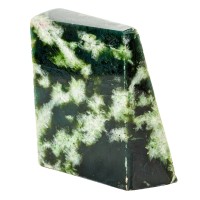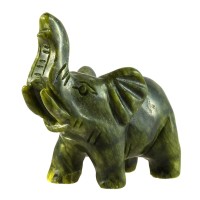Nephrite - knowledge base, jewelry
Properties of nephrite, physiological effects, zodiac signs and nephrite jewelry.










Two different gemstone materials can be correctly called jade.
The jade and the other is nephrite. Both are actually metamorphic rocks, made up of tiny, interlocking mineral crystals. These interconnected crystals make both gemstones exceptionally tough. Jade is available in many colors: Many shades of green, yellow, and reddish orange, as well as white, gray, black, brown, and lavender (often light purple or light gray-purple). Its color is often striped or mottled, giving jade gemstones an interesting visual texture from which interesting effects can be created when polished. Gemologists use the word “jade” to refer to both jade and nephrite. These gems have been linked throughout history. The name jade has also been used for many gemstones and ornaments that only resemble jade.
Nephrite is also accepted in the gem and jewellery industry as jade. It can be translucent or opaque, light or dark green, yellow, brown, grey or white. Its colours are usually duller than jade.
Chemical and physical properties of nephrite:
Formula:
Ca2(Mg,Fe)5Si8O22(OH)2
Crystal system:
monoclinic
Category:
inosilicate
Color:
greenish white, green, yellowish, grey
Streak:
white
Transparency:
translucent, opaque
Cleavage:
none
Fracture:
splintery
Mohs scale hardeness:
6,0 – 6,5
Specific gravity:
2,9 – 3,03 g/cm³
Major metaphysical healing properties attributed to nephrite:
Improves kidney function, prevents kidney diseases, prevents kidney stone deposition, has a detoxifying effect.
Zodiacs associated with nephrite (jade) gemstones:
Nephrite is the gemstone of the zodiac sign of Pisces and Virgo.
Click here to read about the general characteristics of horoscopes!
Use of nephrite:
Ornaments, jewelry.
Occurrence of nephrite
Poland, Canada, China, Russia, Burma, New Zealand, Tasmania, Brazil, Mexico, Taiwan





